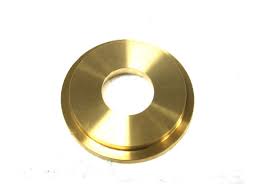If you own a boat that has an outboard motor on it or boat with a sterndrive system, the propeller shaft must have what is called a thrust washer on it that is positioned on the shaft in front of the boat propeller. The thrust washer has two functions. The first reason why you must use one is it stops boat propellers from sliding forward on the prop shaft while being run in forward gear. That would cause damage to the lower unit housing from coming in contact with the rotating boat prop.
The propeller would also be damaged which would not be repairable along with possibly the lower unit housing not being repairable. The second reason is it centers and secures the front of the boat prop when the prop nut on the shaft is tightened to the proper torque spec. There are two thrust washer designs that achieve this. One is just flat on the side that contacts the propeller that makes it impossible for the boat prop to wobble once the prop nut is tight. The other design has a smaller diameter protruding inner shoulder to it that tucks inside the front of the prop that also centers and secures the front of the boat propeller.
You must use the correct thrust washer for your prop shaft to insure the propeller will be inside the lower unit housing at the proper depth so the exhaust gases will only exit out the center of the propeller instead of out over the propeller blades which would cause a huge loss of performance.
When changing out boat propellers make sure the thrust washer is on the prop shaft before installing the replacement propeller and not stuck inside the front of the prop you are taking off.
Pry it out of the old prop if it’s still in it and put it on the shaft. When changing boat props you should take the thrust washer off the shaft and check if there is any fishing line wrapped around the shaft that you sometimes you pick up while using your boat and remove this line. This fishing line can damage the rubber waterproof seal that the prop shaft goes through and that could lead to water entering the lower unit gear housing and contaminating the gear oil in the housing. If you suspect this has happened you can check it yourself by having the boat out of the water and let it sit overnight. Then just unscrew the gear oil drain plug on the gear housing just enough to see what comes out of the lower unit. Water is heavier than oil so it will drip out before any oil does. If pure oil comes out immediately then you are ok. If you have just a little water then oil coming out, secure the drain plug and run your boat a little bit then check for water again. If no water comes out the seal should be good but still check for water periodically. If water comes out, your propeller shaft seal needs to be replaced by a certified marine technician.

Recent Comments